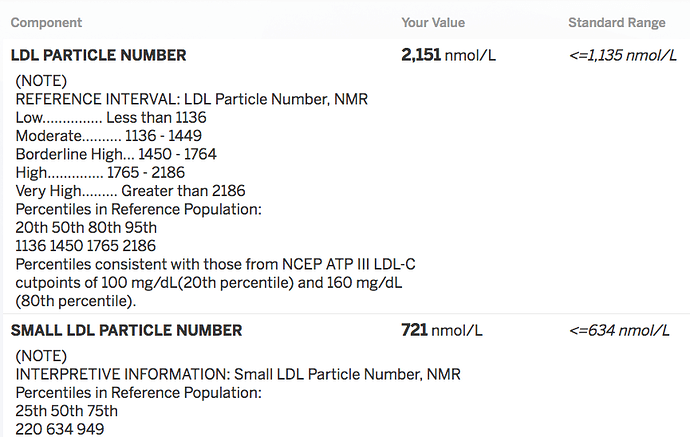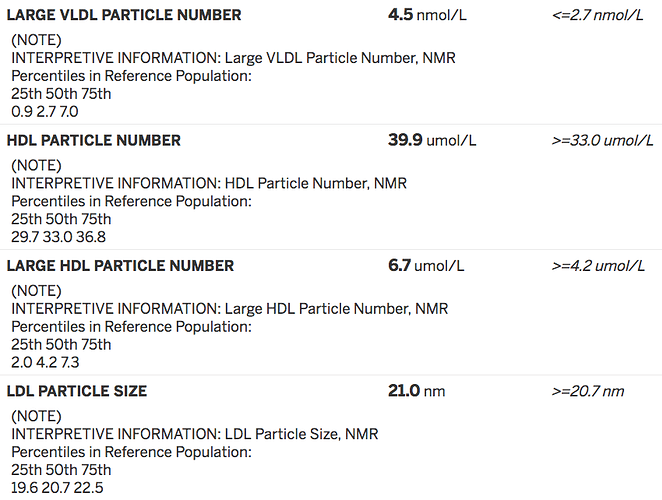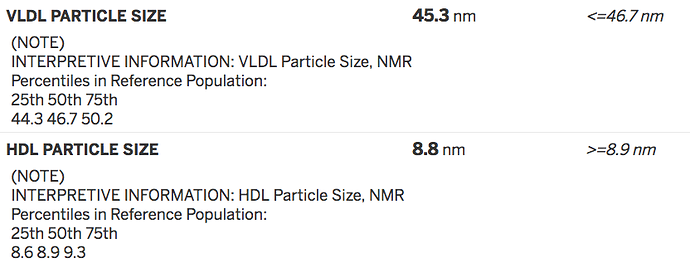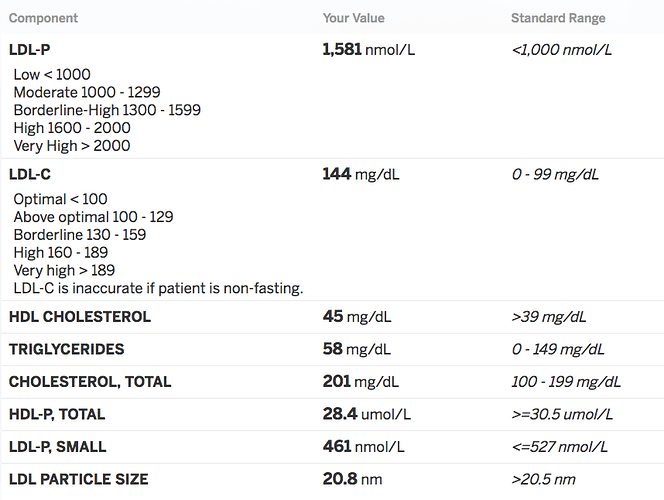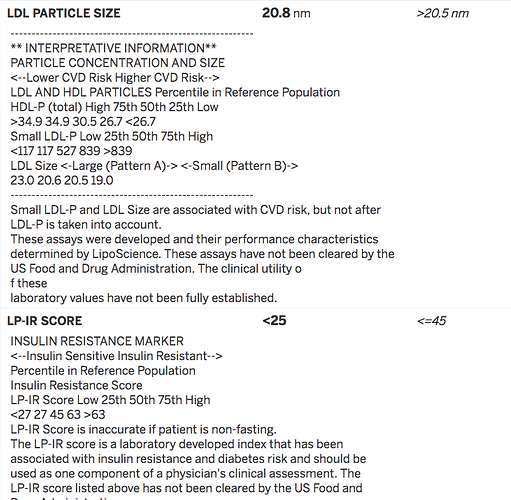TL;DR: I’ve been eating an excellent diet of late and my trigs have skyrocketed. Particle sizes also not great. Here are the screenshots. What the hell is going on?!
Freaking out latest NMR cholesterol results
It’s mystifying, and I hope one of the experts will chime in. The only thing I have to suggest looking at is whether it might be possible that hidden carbs have somehow crept into your diet? Also, are you getting enough saturated fat?
I’ve substantially increased my saturated fat intake since summer. While it’s true that I was in ketosis for 2 months of the summer prior to that previous test, and I’m just low carb but not in ketosis now, I cannot see how that explains it. My carbs are all from a bit of half and half milk in my cappuccino and some 100% dark choc. Minimal sugar. All my other biomarkers are great, weight is dropping again.
It makes no sense unless you accept that saturates CAN cause blood lipid dysregulation.
Let’s hope Richard and Dave Feldman have some light to shed on the subject, then.
what about important blood work like A1c, fasting insulin ?
Lipids dont really excite me.
They look fine from August so I would have told you not to bother.
What are your weight loss and /LCHF keto goals ?
Good questions. That’s what’s so weird. Here’s the basics:
CRP was 0.99 a few months ago EDIT: and it was 0.6 in October
A1C was 4.8, is now 4.7
Fasting BG is 83
Fasting insulin was 10 (top of normal range) back in October, planning to re-test
OGTT in October showed fasting insulin 10 and somewhat low BG at 2 hours, but otherwise pattern 1 according to @richard and also Ivor Cummins
My current goal is to drop another 5kg from current weight of 79ish. Since starting strength training a few weeks ago, that’s moving forward. Here’s my 30-day weight average, the dip in the middle was from using a different scale in Australia, it’s not a reflection of actual weight loss. So the recent downward trend is new, and I think a result of strength training.
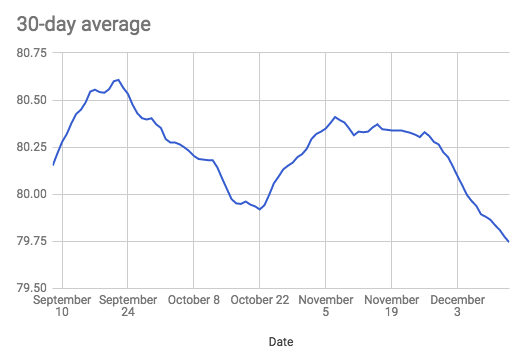
Any insight you guys can give me would be most welcome. My understanding is that my trigs should NOT be behaving badly like this. Nor should the lipoprotein particle sizes.
Had a fasting NMR done in April, and then another one not fasting in July. I agree with @VLC.MD I shouldn’t have bothered. I did OMAD normally so my LDL-P was High as well, small LDL-P was a little more than yours, and the IR value was borderline high IR.
If I had known about the Cholesterol experiment by Dave Feldman, I would have done it prior to the 2nd NMR. As it is I didn’t really show much improvement and feel that ~$100 was a waste.
I like @DaveKeto 's term ‘trafficking’ in more LDL when you’re regularly doing IF, but this whole year I haven’t had 3 regular meals, it would feel like I’m gorging.
Update: my cardiologist doesn’t seem too concerned. He says my trigs are at the upper end of normal and it’s not worth freaking out.
He says continue low carb, “and just replace animal fats and protein with plants based fat and protein as much as possible and then reassess.”
He’s always said he feels that all animal products are problematic. I think he means animals other than fish. I’m not inclined to dismiss this view completely.
For a start, I’ve been eating too much oil/fat. There is no need for me to consume 70% or more of my calories from fat. I’m eating past satiety, and this is exactly why --too much fat. I’m going to reduce my fat intake somewhat to let my body burn its stored fat, and I’m also going to use more olive oil in place of butter.
I’m going to also investigate oils like safflower, which I understand even Phinney finds quite acceptable. Which is a surprise to me, bc I thought all veg/seed oils were “bad” for us. Clearly I have a lot still to learn about fats.
Types of Fat in food: Saturated, Monounsaturated, Polyunsaturated
Dr Phinney likes a High Oleic Safflower oil … but I haven’t been able to find that here in Australia. It is supposed to have more monounsaturated Oleic acid than regular safflower oil.
I might be tempted to use Olive oil or Avocado oil for cold oil uses such as salad dressing, emulsifications like mayonnaise or mousse, and for monte’ing sauces (adding at the end of the development of a sauce to give it gloss and mouth feel), and coconut oil for hot oil uses like shallow frying.
Types of Fat in food: Saturated, Monounsaturated, Polyunsaturated
In what foods ?
Frying ?
I’m slowly learning about fats here.
I’ve always used olive oil for everything.
So before commenting — some important qualifiers…
- How long were you water fasted before this last test? (No coffee or other substance)
- Have you been tracking your diet closely? If so, do you know how much the new carbs were in addition to the existing total fat in your diet?
Re oils: I actually fried latkes in olive oil last night and didn’t get any smoke till just as I removed the latkes from the frying. But if you say coconut oil is superior, great! I’ll try finding high oleic safflower too. Generally I fry things like eggs in butter, but I’m trying to follow my doc advice and (reluctantly) try using non-animal fats for a while…
Hey Dave, thanks for the questions. Pretty sure I was fasted for at least 8 hours. Was probably more like 9 or 10 hours. The blood draw was 9am and I am fairly sure I had nothing after midnight, and it’s possible I had nothing after 10.30 or 11.
I haven’t been tracking my diet closely. I’m not sure what you mean by new carbs, and I can’t recall exactly what I ate that week. However, a typical day for me recently has been:
- Usually don’t take in any calories until after midday
- 2 dry cappuccinos with half and half milk, recently I’ve been breaking my IF and starting these late morning
- late lunch (usually after 2pm) of either butter chicken with sagh paneer at an Indian restaurant (which I may have had the day before the blood draw) or, more usually, salmon and roast/mash cauliflower with half an avocado and lots of olive oil on top.
- a similar dinner – sous vide steak seared in butter, or roast wild fish, with cauliflower mash
- snacks are usually after dinner, and they include cheese, full fat cottage cheese, 100% dark chocolate with stevia drops, that week I may have been eating 300 calories’ worth of 80% dark chocolate which included sugar (yes I was cheating a bit!)
- the last few weeks I was drinking some red wine, and I was having the occasional nip of tequila.
- drinks = water or SodaStream completely unflavoured.
I’m sure I’m forgetting something but does that answer your question? Since summer I’ve definitely been low carb compared to SAD, but the half and half milk, dark choc, and red wine in particular have certainly been bringing me up above 20 or 30 net carbs.
I’ve been meaning to track my macro grams for a few days, wish I’d done it before the test!
By the way: my cardiologist, as I noted above, expressed limited concern about these numbers. I’m wondering what your thoughts are about them. The silver lining is my HDL is great!
So overall, I’m not that concerned. Like your cardiologist, I think of your TG as right at the line. In fact, on my recent “Basics” video, I address 150 or less as the cut point I referring to with TG. Moreover, as I often point out, TG is the “noisiest” of the markers I track. It has an inverse correlation like LDL-C, etc, but with a higher deviation (which makes sense given what it is).
The tricky part in assessing why TG is high is that it has a lot of preceding mechanisms that can explain it as a final outcome. Here’s my off-the-cuff list in order of my assumption:
-
You’re in an energy surplus while being fat adapted. I see this within my own circle of family/friends when they go full keto and then start “loosening” up the reins a bit. I won’t take the time to get into the technicals of this, but I’ll just say TG is a great canary in the coal mine that you’ve gotten used to high levels of fat while now adding (on net) more energy from carbs. This can be easily detected by simply tracking your food, of course.
-
You had less overall calories in the days before the test, while still being full keto. I know, I know, this seems to contradict the one above, but it doesn’t. If you’re fat-adapted but in an overall energy deficit, the body mobilizes more VLDLs to compensate the difference (as per my Inversion Pattern talk at Breck). Again, this too is easily determined by tracking your diet.
-
You have something you’re fighting inside the body, transient or otherwise (but if so, usually transient). This possibility is much less likely but worth a mention. If @siobhan wants to chime in, this is more her department than mine.

-
It’s genetic (super highly unlikely given your prior tests confirming change).
Hope this helps!
Do you know what your other “system” markers are? I didn’t see CRP from this test.
I’d also look at ferritin, and GGT, you said fasting insulin is normal…
Could be a few things… you said probably fasted 8 hours? Could be under 12-14 is a problem.
Could be youve some transient subclinical issue going on like a minor infection (would be reflected w/ higher ferritin and CRP)
But I would bet the eating past satiety thing is key here. Something thats highlighted here often is eat to satiety. So I would say try eating fat to satiety for a while and retest, see if that’s the issue. As Dave said, TG is a marker of unspent energy, after all…
I completely agree that there is no reason to eat more just to reach a macro %. Your body is way smarter than any calculator is.
But I’d agree that 150 TG is within normal range and as Dave said can fluctuate.
That is just my hobbyist opinion.
To recap:
CRP, ferritin good? GGT if you have it?
Try eating to satiety for a while, retest.
If that doesnt work, try swapping animal fat, retest (following doc’s orders and see if it works)
There is an argument that can be made that animal protein should not be eaten in excess. Dr. Mercola advocates a HFLC diet and makes this case in his book, Fat For Fuel.
I haven’t seen any studies, but I’m skeptical that consuming tons of oils is conducive to optimal health. I don’t use oils solely to meet macros/calories. I get most of my fat from whole foods like avocados, nuts, dairy, seeds, olives. A large portion of my meat consumption is from fish, especially Chilean sea bass, salmon, anchovies, tuna, and sardines. I’m not a hyper responder so I can’t comment on impact it would have on improving cholesterol numbers, though my numbers are good.
I’m the same exact way. If I do a 24 hour fast before blood work my TG’s are around 150. If I do 12 hours they are around 50.
Last time this happened I did the 12 hr fast before my blood was drawn and my TGs were 53. This was less than a week later.
I’ve been low carb since 2013 and strict keto for the past 2 years.
So as @DaveKeto stated in his replay (#2) above 


